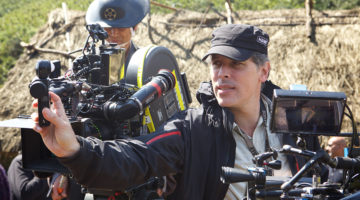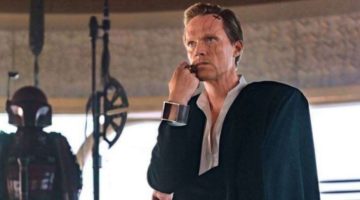Interview: Director Steven Knight talks Locke
Locke is a rather extraordinary look at an ordinary man. It’s complex in its issues, but simple in scope. It is incredibly intense without anything particular tangible at stake. It is, ultimately, a 90-minute car ride alongside a man who is attempting to fix problems he has creating through talking on the phone.
“The thing that I’m always interested to most in above anything else is dialogue. If you have something like this and you don’t have precise dialogue, you only have a performance,” explained director Steven Knight during an interview in Toronto ahead of the film’s release. “This is a lot more like a theatre piece, which is always how Tom and I wanted to approach this.”
The “Tom” is British actor Tom Hardy, better known for playing a variety of extreme or exaggerated people, like the supervillain Bain or the disillusioned madman Bronson. Here he plays Ivan Locke, a father, husband, and successful construction manager whose life is slowly unraveling across one evening due to a sense of duty and obligation.
“I think that he has one of those faces that people can look at for a long time and the presence to match,” said Knight of Hardy. “We tried to mess him up a bit with the beard and his jumper so he didn’t look so moody, but even so he still has that certain quality. He’s just so riveting. He even said it himself that this was really his first “straight” role where he isn’t playing a madman or someone becoming a monster or someone who’s angry all the time.”
“The original idea for Ivan Locke was to make him the most ordinary person possible. Give him and ordinary job, an ordinary domestic life, and send him on an ordinary journey where something happens that makes everything change for him.”
Metaphors abound: Locke works with concrete, and has a live with a solid foundation. He approaches everything rationally, despite the chaos of life. As he seeks to correct a mistake, he too approaches that in the most logical way he can imagine. He tries to stay calm as he journeys to his destination, despite getting calls from his wife, sons, boss, and employee, all with problems and searching for answers.
It is entirely a film of Tom Hardy driving in his BMW and talking on the phone. There are no other actors on screen. Knight explained that Hardy had a script in front of him while driving that he adhered to, though he wouldn’t know when calls were coming in. They weren’t playing tricks on Hardy, but they set up a world in which things would be as real as possible.
“To Tom’s credit it’s really hard to keep that going when we had to stop every 27 minutes to change out the cards and the lenses in the cameras,” said Knight. “It was like a Formula One pit stop. We’d pull the memory card, change the lens, but we would leave Tom exactly as he was. I actually spoke to Tom as little as possible.”
In all, the film seemed to be realized in full as it had been envisioned by Knight’s script. The environment was controlled, and everything was off perfectly – almost.
“This film had a really charmed life,” said Knight. “Everything worked and it worked really quickly. Once we got the method of shooting established, then it was all very controlled. I mean, there were lots of hitches, but our policy was: anything that goes wrong, use it and keep it. Tom showed up on the first day of shooting with a cold, and so rather than try to disguise that fact, we worked it into the film. We opened ourselves up to all that chaotic stuff.”
Another snag worked its way into the film. They were shooting in a BMW, but not always driving, and so they wouldn’t fill up the tank. Well, every 12 minutes or so, the car would beep due to an empty tank, and for some time no one knew what was happening.
“Every time that happened, Tom would get go pissed off and just curse and bang the steering wheel,” told Knight. “So we kept that in, but instead of the noise, we dubbed over it with ‘You have a call waiting.’ It looks as if he’s annoyed by another call coming in, but really he’s just mad that noise happened again.”
Still, it’s no easy task to pull off. “I knew that within seven minutes of the opening of the film, we would need to get the audience engaged with the situation because unless you make them care about the dialogue, all people will think about at the end of the day is why the film was even made in the first place instead of thinking about the characters. The action is all about the character and the dialogue is a big part of how that was done.”
Photo Credit: Elevation Pictures




